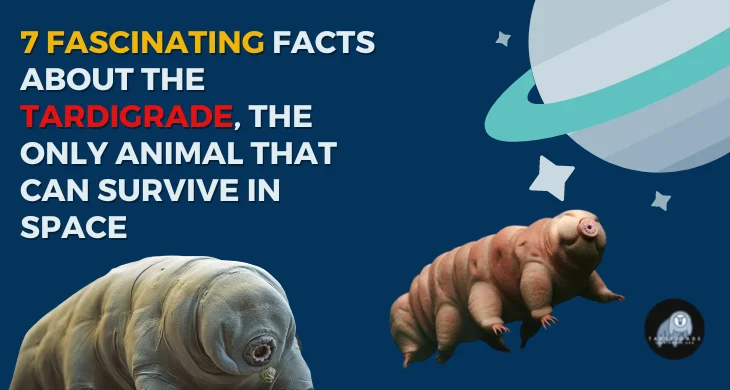Introducing the remarkable tardigrade, a microscopic marvel renowned for its incredible resilience and the ability to survive extreme conditions, including the vacuum of space. Explore seven fascinating facts that illuminate the unique adaptations and features that make tardigrades the only known animal capable of enduring the harsh challenges beyond our planet. Journey into the extraordinary world of these resilient water bears and uncover the secrets of their space survival.
Extreme Resilience
Tardigrades, often referred to as water bears, are remarkable microscopic organisms known for their extraordinary resilience. One of their most fascinating attributes is their ability to endure extreme conditions that would be fatal to most other life forms. These tiny creatures can withstand exposure to ionizing radiation, extreme pressures, and a wide range of temperatures.
In terms of radiation, tardigrades have displayed an impressive resistance to ionizing radiation, including levels that would be lethal to humans. This unique capability has sparked interest in studying their DNA repair mechanisms for potential applications in human space exploration and medical research.
Additionally, tardigrades exhibit resistance to high pressures, allowing them to thrive in environments such as deep-sea trenches. They can endure pressures that are several times greater than those found at the deepest parts of the ocean.
Furthermore, these resilient organisms can withstand temperatures ranging from absolute zero (minus 273.15 degrees Celsius) to well above the boiling point of water. This broad thermal tolerance enables them to survive in diverse habitats, from the freezing Arctic to scorching deserts.
The extreme resilience of tardigrades, coupled with their ability to enter a state of cryptobiosis, where they lose almost all of their water content and essentially shut down metabolically, contributes to their unparalleled survival capabilities in some of the harshest environments on Earth and even in the vacuum of space.
Cryptobiosis Survival
Tardigrades showcase a remarkable survival strategy known as cryptobiosis, a state in which they undergo extreme dehydration, effectively shutting down their metabolic processes. When conditions become unfavorable, tardigrades curl into a dehydrated ball, reducing their water content to a minimum.
This cryptobiotic state allows tardigrades to endure harsh and inhospitable environments, including the vacuum of outer space. In experiments conducted on the International Space Station, researchers exposed dehydrated tardigrades to the extreme conditions of space, and astonishingly, many of them survived and were able to resume normal activity upon rehydration.
The ability to enter cryptobiosis is a key factor in tardigrades’ resilience and their reputation as the only known animal capable of surviving the harsh conditions of space, further emphasizing their exceptional adaptability and survival mechanisms.
Wide Habitat Range
Tardigrades, often referred to as water bears, exhibit an extraordinary range of habitats, showcasing their unparalleled adaptability. These microscopic animals can be found in diverse environments, spanning from the deepest ocean trenches to the highest mountain peaks. Their ability to thrive in such varied conditions is a testament to their resilience and adaptability.
Tardigrades have been discovered in mosses, lichens, leaf litter, soil, and even on the surfaces of buildings. This wide distribution highlights their capacity to endure and adapt to different climates, temperatures, and levels of humidity. Whether in the depths of the ocean, high-altitude alpine regions, or urban landscapes, tardigrades persist in their ability to occupy a remarkably broad spectrum of habitats, contributing to their status as one of the most resilient life forms on Earth.
Ancient Existence
Tardigrades, commonly known as water bears, boast an ancient lineage, with a history stretching back over 500 million years. These microscopic animals belong to an evolutionary group that has withstood the test of time, making them one of the oldest known forms of life on Earth.
Their existence predates many major events in the history of our planet, including mass extinctions and the rise and fall of various life forms. Despite the dynamic changes the Earth has undergone, tardigrades have persisted, showcasing remarkable adaptability and resilience.
This ancient existence places tardigrades among the enduring survivors of evolutionary processes, offering scientists valuable insights into the adaptive strategies that have allowed them to thrive for such an extended period. The study of tardigrades contributes not only to our understanding of these fascinating creatures but also to the broader narrative of life’s journey through Earth’s geological epochs.
Microscopic Size
Despite their ancient existence and remarkable resilience, tardigrades are characterized by their microscopic size. Commonly referred to as water bears, these creatures are incredibly small, with a typical length of about 0.5 millimeters. This minuscule size renders them invisible to the naked eye, highlighting the need for specialized microscopic tools to observe and study these fascinating organisms.
Their diminutive stature is a key aspect of their unique biology, allowing them to inhabit a wide range of environments and navigate spaces that larger organisms may find challenging. The microscopic world of tardigrades holds a wealth of secrets waiting to be uncovered through scientific exploration and research.
Global Distribution
Tardigrades, often referred to as water bears, boast a truly global distribution, showcasing their adaptability to diverse environments. These microscopic animals are found across the globe, spanning various ecosystems, including terrestrial, freshwater, and marine habitats. Their ability to thrive in such a wide range of conditions is a testament to their resilience and evolutionary success.
On land, tardigrades can be discovered in mosses, lichens, leaf litter, and soil, demonstrating their presence in terrestrial environments. They are equally at home in freshwater ecosystems, residing in lakes, rivers, and other aquatic settings. Additionally, tardigrades have been identified in marine environments, emphasizing their versatility in adapting to the challenges posed by saltwater conditions.
This global distribution underscores the ubiquity of tardigrades and their capacity to endure diverse climates and geographical locations. Scientists continue to explore the intricacies of their distribution patterns and the specific adaptations that enable them to inhabit such a wide array of habitats. Understanding the global distribution of tardigrades contributes to our broader knowledge of the biodiversity and ecological dynamics that shape life on Earth.
Space Survivors
Tardigrades, those remarkable microscopic creatures, have earned the title of space survivors due to their extraordinary ability to endure the harsh conditions of outer space. In scientific experiments, tardigrades have demonstrated an unparalleled resilience to the vacuum of space, showcasing their unique adaptations that allow them to withstand the challenges beyond Earth’s atmosphere.
In these experiments, researchers exposed tardigrades to the extreme conditions of space, including the vacuum, radiation, and microgravity present in the cosmic environment. Astonishingly, tardigrades not only survived but also exhibited a capacity to endure these extraterrestrial conditions for extended periods.
The key to their space survival lies in their ability to enter a state known as cryptobiosis. In response to desiccation or extreme environmental stress, tardigrades can undergo cryptobiosis by curling into a dehydrated ball. This cryptobiotic state shields them from the detrimental effects of the vacuum of space, radiation exposure, and other challenges.
Tardigrades’ capacity to survive in the vacuum of space has significant implications for astrobiology and our understanding of life’s potential beyond Earth. Their resilience sparks curiosity about the possibility of life existing or surviving in extreme environments on other celestial bodies. As scientists delve into the mysteries of these space survivors, tardigrades continue to contribute valuable insights into the limits of life in the cosmos.
Conclusion
In conclusion, the tardigrade, often referred to as the water bear, stands as a testament to the wonders of resilience and adaptability in the animal kingdom. With its ability to endure extreme conditions on Earth and even survive the vacuum of space, the tardigrade has captured the fascination of scientists and space enthusiasts alike. As researchers continue to unravel the secrets of these microscopic marvels, the tardigrade’s unique characteristics provide valuable insights into the potential for life beyond our planet and the incredible adaptability of living organisms.
FAQ’S
- Q: What is a tardigrade?
- A: A tardigrade is a microscopic, water-dwelling animal known for its extreme resilience and ability to withstand a variety of harsh conditions.
- Q: Why are tardigrades called “water bears”?
- A: Tardigrades earned the nickname “water bears” due to their bear-like appearance and their habitat in water.
- Q: How small are tardigrades?
- A: Tardigrades are typically about 0.5 millimeters in length, making them invisible to the naked eye.
- Q: Where do tardigrades live?
- A: Tardigrades inhabit a wide range of environments, including terrestrial, freshwater, and marine ecosystems. They are found globally.
- Q: What is cryptobiosis?
- A: Cryptobiosis is a state in which tardigrades can enter, resembling a dehydrated ball. This state allows them to endure extreme conditions.
- Q: Can tardigrades survive in space?
- A: Yes, tardigrades have demonstrated survival in the vacuum of space, making them the only animals known to endure the challenges beyond Earth’s atmosphere.

